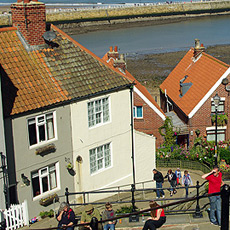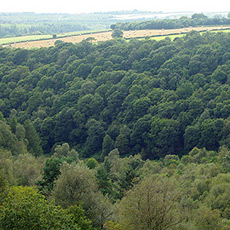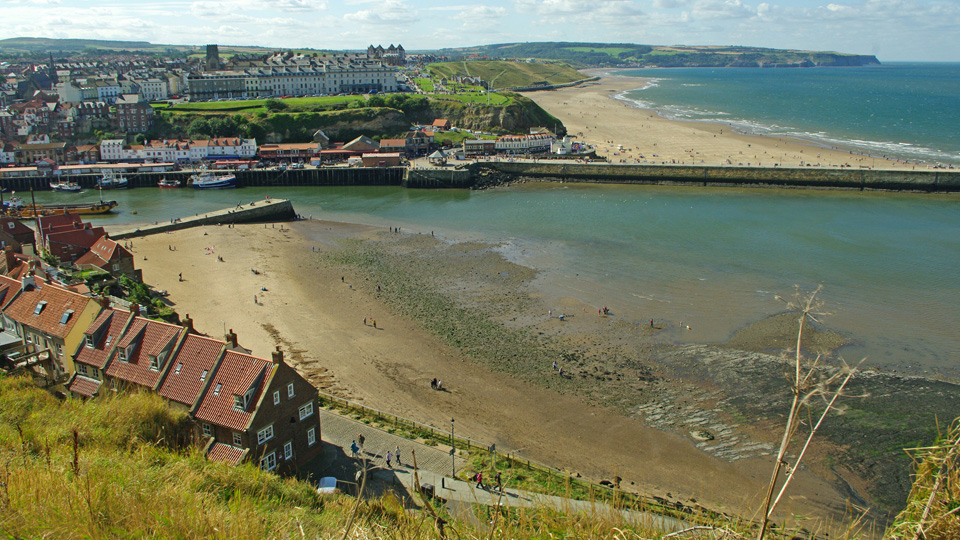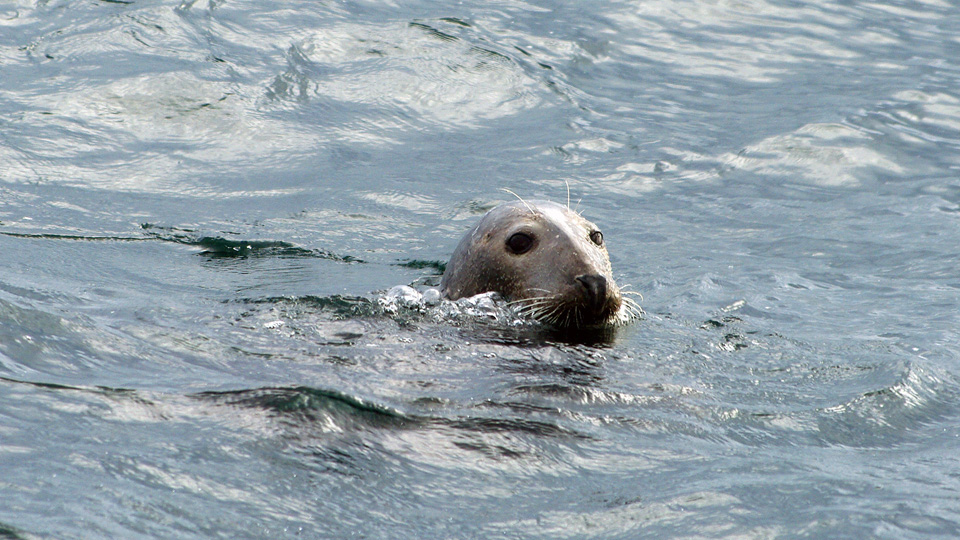Whitby - History - Seaside Town - Edge of a National Park
Pictures: Whitby | North Yorkshire Moors
Whitby in the north of England is a real seaside gem. England has many seaside towns which became popular holiday destinations for ordinary people beginning in Victorian times with the growth of the railways.
The town has managed to buck the trend for decline in some such resorts due to a combination of location and being very picturesque with a long and varied history and variety of activities to do within the town and nearby.
Rising above the town on a cliff top there are the famous Abbey ruins which inspired Bram Stoker to write "Dracula". Leading to the Abbey is a flight of 199 wide steps that rise from the cobbled streets of the old town and past houses built on the hillside to give a fabulous view of the town, harbour and coastline.
The town has a busy marina, a number of boat trips are available lasting from an hour to several hours. There are even whale watching trips to see minke whales and seals offshore that feed on fish shoals. Dolphins, porpoises and other whale species may join in too if you're lucky.
Not too far afield are the beautiful North York Moors national park, and other towns and villages such as the must-visit Robin Hood's Bay.

Whitby Harbour Entrance - Abbey Ruins and St. Mary's Church

Whitby Abbey Ruins - built in the 13th century and reduced to a ruin in the 18th, the inspiration for Bram Stoker's Dracula
A Brief History
- 656 - Earliest record of a settlement, first Abbey erected.
- 1078 - First use of the name Whitby, remains a small fishing community for several centuries.
- 18th Century - Becomes a shipbuilding and whaling center with an active port. Locally mined alum and jet are traded.
- 1764 - The Endeavour captained by Cook on his voyage to Australia is built at Whitby.
- Georgian times - 1714-1830 - Whitby develops as a Spa Town.
- 1839 - The railway reaches Whitby and contributes to the town's tourism development.
- 1914 - Abbey sustains considerable damage after being shelled by German battleships (aiming elsewhere).












































Where to go in Whitby
There is plenty of choice of
what to do and other people's favourites
might not necessarily be yours, here's
some to start with, you will no doubt
find your own preferences as you wander
about. In no particular order:
Have fish and chips and eat them while looking out to sea - This is something that applies whenever you are at the sea-side, it makes the whole eating experience more pleasurable. The Magpie Cafe is the most famous fish and chip bar in Whitby but by no means the only one and others are of a high standard too. You can eat in or take out..
Walk up the 199 steps and visit the Abbey - Tradition dictates that you should count the steps as you climb, I only heard this after the event however and I'm happy to trust others who say they've counted 199. They lead from the eclectic mix of shops in the old town up to the Abbey ruins, church and graveyard on the East Cliff. The Abbey grounds and visitor center are run by English Heritage with an entry fee, though there is plenty to see and free walks with great views regardless. You can also visit the 11th century St. Marty's church. It is possible to drive up if you can't or don't want to tackle the steps.
In Bram Stoker's "Dracula", the Count leapt ashore from the grounded Russian schooner the "Demeter" in the form of a huge black dog and ran up the 199 steps towards the Abbey, leaving behind a crew that were all dead and the captain lashed to the wheel.
Walk around the harbour - Go crabbing from the harbour wall using bacon fat as bait, explore the myriad of shops in and around the harbour area, walk out as far as you feel like along the harbour walls to the lighthouse (£1.50 entry).
Walk / play on the beach - a large beach which becomes huge at low tide. Great for kids making sandcastles or to walk the dog (October to May on the west beach, all year round on the east beach) it is North Yorkshire however and the North Sea, so don't rely on sunbathing or swimming in the sea here most of the time unless you like it on the "bracing" side.
Whitby Museum - In the middle of Pannett Park centrally placed in town. If you like museums at all you'll love this place, the theme is "some sort of connection to Whitby" and is an eclectic pot-pourri of all sorts of fascinating stuff. It deserves more than one visit which is just as well as the £5 entry ticket allows you repeat visits for a year.
Go on a boat trip - There are a number of boat trips leaving from the harbour going out to sea or up the river from £3 for adults and free for under 5's. Choose from an old lifeboat, the "Captain Cook Experience" or more conventional craft, longer trips are available including fishing trips. Going on boats for their own sake is worth the effort alone, the view of Whitby from seawards makes it more than worth it.
Fossil hunt on the beach below the east cliffs at low tide - Fossil ammonites, shells and reptiles as well as pieces of jet, the fossilized resin of monkey puzzle trees used for making jewellery, can be found for about 3-4 hours around low tide. The area is designated as a SSSI, a site of special scientific interest. The best time is following winter storms when new material is exposed. It's not suitable for small or unsupervised children and make sure you don't get cut off by the tide which goes right up to the cliff base. There are sometimes guided walks, look for announcements of these in the local fossil and gemstones shops.
Where to go around Whitby
Robin Hood's Bay
- A village as well as a bay, about
7 miles from Whitby, if you're feeling
energetic you can walk there and return
to Whitby again by bus (the X93 every
half an hour or so -
timetable). A lovely picturesque
place with cobblestone streets and a
very steep road down
into the village from the pay and display
car park at the top of the hill. Don't
try taking your car down into the village
if you're visiting, the roads are very
narrow and there is virtually no other
parking. Lots of interesting little
shops, pubs and cafes to sit and watch
the world go by from and a nice little
beach too. Allow 2-4 hours.
Take a steam train on the North Yorkshire Moors Railway - Goes as far as Pickering with its 1930's themed station with a few other stops including Goathland which was Goatsmeade Station in the first Harry Potter film and Aidensfield in ITV's Heartbeat programme. Daily from March to October, very limited service in the winter months. website
North York Moors National Park - Surrounding Whitby and somewhere you should make the effort to get out and see. There are many walks you can take of various lengths and difficulty. Dalby Forest and the walk to the Low Bride Stones from the car park is within easy reach by car.
Scarborough Castle - Explore the castle and picnic in the grounds, pay to enter and part of English Heritage, the current castle ruins date from the 12th century, but the history of settlement on the headland where the castle stands goes back about 3,000 years. About 20 miles from Whitby.

Ruins of Whitby Abbey - A Former monastic abbey and then part of a private estate

Overlooking Whitby Harbour - from the East Cliff

Whitby Harbour - holiday cottages in the foreground

Whitby Beach - town and harbour

A Gannet - one of Britain's most impressive sea-birds, as here, they can be seen from small boats off the coast

Busker - Old Town

Caedmon's Cross - the earliest recognised English poet In St. Mary's church graveyard, a late Victorian Celtic cross

The Bottom of the 199 Steps - not an easy climb, but lots of stops and you'll do it

Sheep on the North York Moors - you drive across this National Park to reach Whitby

A Common Seal - in the sea off Whitby, there are many boat trips of various lengths

199 Steps

Whalebone Arch - a symbol of Whitby's past as a whaling port

Captain Cook Statue - Cook was an apprentice in Whitby

North York Moors National Park

North York Moors Low Bride Stones Dalby Forest above Eskdale

Dalby Forest - looking across to farmland in the distance

Heather In flower, August

North York Moors Low Bride Stones Dalby Forest above Eskdale
More pictures: Whitby | North Yorkshire Moors
![]()
© copyright 2017 to present Paul Ward, all Rights Reserved | | privacy policy


